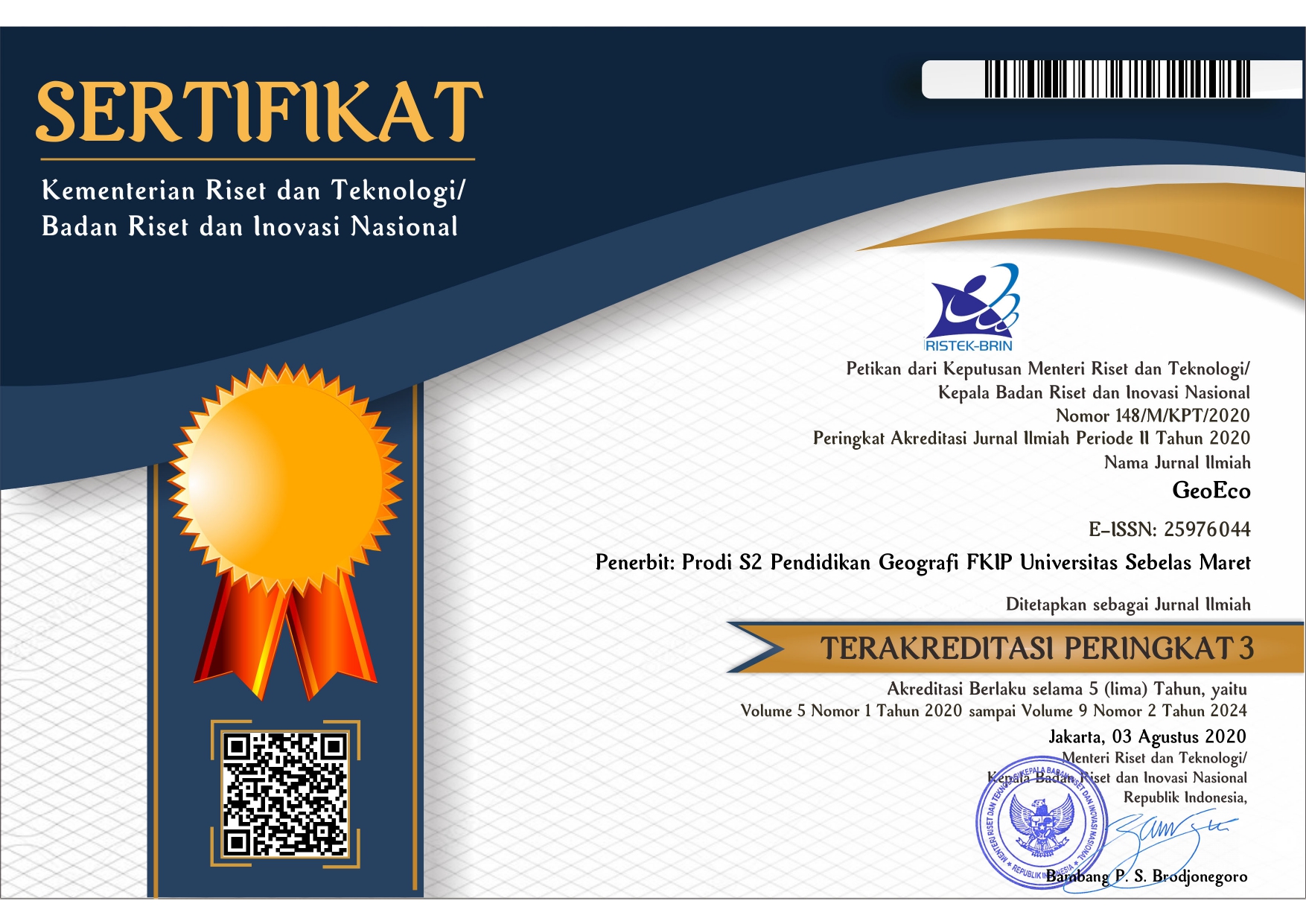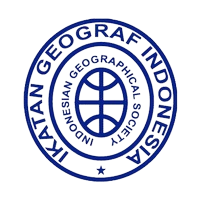SPATIO TEMPORAL ANALYSIS TO INDICATIONS OF URBAN HEAT ISLAND IN JAMBI CITY
Abstract
The high population growth in Jambi City has resulted in land conversion from vegetation to built-up land and settlements, and the use of motorized vehicles has increased the release of carbon emissions which also increase air temperature in Jambi City. To better understand and identify the urban heat island (UHI) phenomenon, spatial and temporal analysis is needed using remote sensing data with a long series from 2000 to 2024. This study aims to examine the intensity of UHI in Jambi City by measuring the surface urban heat island index (SUHII) and the urban thermal field variance index (UTFVI) by utilizing the Land Surface Temperature (LST) and Enhanced Vegetation Index (EVI) products. Correlation analysis shows that Jambi City is an area with the highest LST and the lowest EVI index compared to the surrounding areas. The SUHI intensity in Jambi City has a positive value between 0.2 - 2.5 °C. Meanwhile, the intensity of AUHI between urban and suburban areas ranges from -0.2 - 0.3 °C during the day and -0.1 - 0.1 °C at night. The UTFVI index is in the range of 0.01 - 0.07. Although the intensity of SUHI and AUHI is not too large and the decrease in EVI value can be an indicator of UHI in Jambi City. The correlation test between LST and air temperature of the station has a sufficient category except for the correlation between LST and air temperature of the Kerinci Meteorological Station which has a very weak category.
Keywords
Full Text:
PDFReferences
Alfath, M. W., & Anna, A. N. (2024). Analisis Multi-Temporal Hubungan Faktor Fisik Penyusun Fenomena Urban Heat Island di Kawasan Petanglong Menggunakan Citra Landsat 8 & 9 (Studi Kasus Tahun 2019-2023). Universitas Muhammadiyah Surakarta.
ALWI, L. O., GANDRI, L., HIDAYAT, H., TUWU, E. R., BANA, S., FITRIANI, V., & INDRIYANI, L. (2022). Analisis Spasial Fenomena Urban Heat Island Kota Kendari Menggunakan Algoritma Land Surface Temperature.
BPS. (2020). Peraturan BPS Nomor 120 Tahun 2020 tentang Klasifikasi Desa Perkotaan dan Perdesaan di Indonesia 2020: Buku 1 Sumatera. Nomor katalog : 1204014. Nomor Publikasi 03100.2103. ISSN/ISBN : 978-602-438-414-2.
BPS Kota Jambi. (2025). Jambi Dalam Angka.
Braak, C. 1928. The Climate of The Netherlands Indies. Proc. Royal Mogn. Meteor. Observ. Batavia, 14 : 192
Chen, X., Su, Z., Ma, Y., Cleverly, J., & Liddell, M. (2017). An accurate estimate of monthly mean land surface temperatures from MODIS clear-sky retrievals. Journal of Hydrometeorology, 18(10), 2827–2847.
Cleugh, H. A., & Oke, T. R. (1986). Suburban-rural energy balance comparisons in summer for Vancouver, BC. Boundary-Layer Meteorology, 36(4), 351–369.
Doni, L. R., Yuliantina, A., Dewi, R., Pahlevi, M. Z., & Kusumawardhani, N. A. (2021). Komparasi Luas Tutupan Lahan di Kota Bandar Lampung Berdasarkan Algoritma NDVI (Normalized Difference Vegetation Index) dan EVI (Enhanced Vegetation Index). Jurnal Geosains Dan Remote Sensing, 2(1), 16–24.
Effendy, S., Bey, A., Zain, A. F. M., & Santoso, I. (2006). Peranan Ruang Terbuka Hijau Dalam Mengendalikan Suhu Udara Dan Urban Heat Island Wilayah Jabotabek (the Role of Urban Green Space in Harnessing Air Temperature and Urban Heat Island. Exemplified by Jabotabek Area). Agromet, 20(1), 23–33.
Fauziah, A. (2021). IDENTIFIKASI PARAMETER PERUBAHAN IKLIM. Magister Ilmu Lingkungan, Universitas Jambi.
Ferdiansyah, M. R., & Siswanto, S. (2024). Assessment of Surface Urban Heat Island in Indonesia’s Municipal Cities BT - Proceedings of the International Conference on Radioscience, Equatorial Atmospheric Science and Environment and Humanosphere Science (S. Lestari, H. Santoso, M. Hendrizan, Trismidianto, G. A. Nugroho, A. Budiyono, & S. Ekawati (Eds.); pp. 795–805). Springer Nature Singapore.
Fire Bulletin, WWF 2007. newberkeley.wordpress.com/wp-content/uploads/2017/03/fct1177084178-kebakaran-hutan-tahun-2006.pdf
Gubernur Sebut Muaro Jambi Daerah Pertumbuhan Baru Ekonomi Jambi. (2024). Https://Jambi.Antaranews.Com. https://jambi.antaranews.com/berita/456254/gubernur-sebut-muarojambi-daerah-pertumbuhan-baru-ekonomi-jambi
Hadibasyir, H. Z., & Firdaus, N. S. (2022). Effect of Vegetation and Building Densities To Urban Thermal Terhadap Kenyamanan Termal Perkotaan ( Studi Kasus Kota Denpasar ) Effect of Vegetation and Building Densities To Urban Thermal Comfort ( Case Study of Denpasar City ). Jurnal Purifikasi, 21(No 1), 11–19.
Hermawan, E. (2015). Fenomena urban heat island (UHI) pada beberapa kota besar di Indonesia sebagai salah satu dampak perubahan lingkungan global. Jurnal Citra Widya Edukasi, 7(1), 33–45.
https://giovanni.gsfc.nasa.gov/. (n.d.).
Https://jdac.jambiprov.go.id. (n.d.). Jumlah Penduduk Kota Jambi 2024. https://jdac.jambiprov.go.id/publikasi/berita/44/data-2024-jumlah-penduduk-kota-jambi-64102-ribu-jiwa44
https://www.jambikota.go.id/. (n.d.).
Jatmiko, R. H., & Hartono, B. P. D. (2016). Penggunaan citra saluran inframerah termal untuk studi perubahan liputan lahan dan suhu sebagai indikator perubahan iklim perkotaan di Yogyakarta. Fakultas Geografi, Universitas Gadjah Mada.
Lo, C. Q., Dale A. (2003). Land-use and land-cover change, urban heat island phenomenon, and health implications. J Photogrammetric Engineering Remote Sensing, 69(9), 1053-1063
Liu, L., & Zhang, Y. (2011). Urban heat island analysis using the landsat TM data and ASTER Data: A case study in Hong Kong. Remote Sensing, 3(7), 1535–1552. https://doi.org/10.3390/rs3071535
Mohajerani, A. B., Jason; Jeffrey-Bailey, Tristan. (2017). The urban heat island effect, its causes, and mitigation, with reference to the thermal properties of asphalt concrete. J Journal of Environmental Management, 197, 522-538.
Mohr, E. C. J., Baren, F. A. van, & Schuylenborgh, J. van. (1972). Tropical Soils. A Comprehensive Study of Their Genesis.
https://mongabay.co.id/2018/02/09/ketika-suhu-jambi-terus-naik-apa-penyebabnya-bagian-1/
Neiburger, M., Edinger, J. G., & Bonner, W. D. (1982). Understanding Our. Atmospheric Environment.
Ngie, A., Abutaleb, K., Ahmed, F., Darwish, A., & Ahmed, M. (2014). Assessment of urban heat island using satellite remotely sensed imagery: a review. South African Geographical Journal= Suid-Afrikaanse Geografiese Tydskrif, 96(2), 198–214.
NINGSIH, R. A. Y. U. (2017). APLIKASI MODEL VECTOR AUTOREGRESSIVE (VAR) UNTUK PERAMALAN SUHU UDARA KOTA PEKANBARU (Studi Kasus: BMKG Stasiun Meteorologi Kelas I Pekanbaru). Universitas Islam Negeri Sultan Syarif Kasim Riau.
Oke, T. R., Spronken-Smith, R. A., Jáuregui, E., & Grimmond, C. S. B. (1999). The energy balance of central Mexico City during the dry season. Atmospheric Environment, 33(24–25), 3919–3930.
Prastyo, F. U., Nurjani, E., & Giyarsih, S. R. (2022). Distribusi Spasial Surface Urban Heat Island (SUHI) Kawasan Permukiman Perkotaan di Kota Yogyakarta. Media Komunikasi Geografi, 23(1), 73–83.
Pratiwi, A. Y., & Jaelani, L. M. (2021). Analisis Perubahan Distribusi Urban Heat Island (UHI) di Kota Surabaya Menggunakan Citra Satelit Landsat Multitemporal. Jurnal Teknik ITS, 9(2), C48–C55.
Purwanto, T. (n.d.). Perubahan Penggunaan Lahan pada Wilayah Suburban Kota Jambi. Http://Lib.Ui.Ac.Id/Opac/Themes/Libri2/Detail.Jsp?Id=20350404&lokasi=lokal. http://lib.ui.ac.id/opac/themes/libri2/detail.jsp?id=20350404&lokasi=lokal
Rezza, M. et al. (2023). Masa Depan Iklim Perkotaan di Indonesia. Klima Media Informasi Dan Publikasi Kedeputian Bidang Klimatologi Edisi IX.
Roth, M. (2013). Handbook of Environmental Fluid Dynamics, Volume Two, edited by Harindra Joseph Shermal Fernando. Matology, 38, e303–e322.
Setiawan, H., & Wibowo, A. (2023). Analisis Tingkat Kesesuaian Lahan Permukiman Berdasarkan Jaringan Jalan di Kota Jambi. Geodika: Jurnal Kajian Ilmu Dan Pendidikan Geografi, 7(2), 186–195.
Singh, R. B., & Grover, A. (2015). Spatial correlations of changing land use, surface temperature (UHI) and NDVI in Delhi using Landsat satellite images. Urban Development Challenges, Risks and Resilience in Asian Mega Cities, 83–97.
Siswanto, S., Nuryanto, D. E., Ferdiansyah, M. R., Prastiwi, A. D., Dewi, O. C., Gamal, A., & Dimyati, M. (2023). Spatio-temporal characteristics of urban heat Island of Jakarta metropolitan. Remote Sensing Applications: Society and Environment, 32(July), 101062. https://doi.org/10.1016/j.rsase.2023.101062
Sobrino, J. A.; Irakulis, I. (2020). A Methodology for Comparing the Surface Urban Heat Island in Selected Urban Agglomerations Around the World from Sentinel-3 SLSTR. Remote Sens. 2020, 12(12), 2052; https://doi.org/10.3390/rs12122052.
SST Optimum Interpolation, NOAA. (n.d.). Https://Www.Cpc.Ncep.Noaa.Gov/Data/Indices/Sstoi.Indices. https://www.cpc.ncep.noaa.gov/data/indices/sstoi.indices
Sutriani, W. (2020). Pengaruh Perubahan Tutupan Lahan Terhadap Peningkatan Suhu Permukaan Kota Jambi. Jurnal Buana, 4(5), 1–88.
Syafitri, R. (2020). Konsep Adaptasi Fenomena UHI (Urban Heat Island) berdasarkan Urban Configuration kawasan Surabaya Timur. Institut Teknology Sepuluh Nopember.
Tursilowati, L. (2002). Urban heat island dan kontribusinya pada perubahan iklim dan hubungannya dengan perubahan lahan. Seminar Nasional Pemanasan Global Dan Perubahan Global. Fakta, Mitigasi, Dan Adaptasi. Pusat Pemanfaatan Sains Atmosfer Dan Iklim LAPAN, 89–96.
V. Miles., & I Esau, (2017). Seasonal and spatial characterictics of urban heat island (UHIs) in Northern West Siberian Cities. Nansen Environmental and Remote Sensing Center/Bjerknes Centre for Climate Research, 5006 Bergen, Norway. Remote Sens. 2017, 9(10), 989; https://doi.org/10.3390/rs9100989
Voogt, J. A. (2002). Urban heat island: causes and consequences of global environmental change (pp. 660-666). Encyclopaedia of Global Environmental Change, 3.
Voogt, J. A., & Oke, T. R. (2003). Thermal remote sensing of urban climates. Remote Sensing of Environment, 86(3), 370–384.
Wang, K., Jiang, S., Wang, J., Zhou, C., Wang, X., & Lee, X. (2017). Comparing the diurnal and seasonal variabilities of atmospheric and surface urban heat islands based on the Beijing urban meteorological network. Journal of Geophysical Research: Atmospheres, 122(4), 2131–2154.
Zhao, J., Zhao, X., Liang, S., Zhou, T., Du, X., Xu, P., & Wu, D. (2020). Assessing the thermal contributions of urban land cover types. Landscape and Urban Planning, 204(19), 103927. https://doi.org/10.1016/j.landurbplan.2020.103927
Refbacks
- There are currently no refbacks.












.png)

